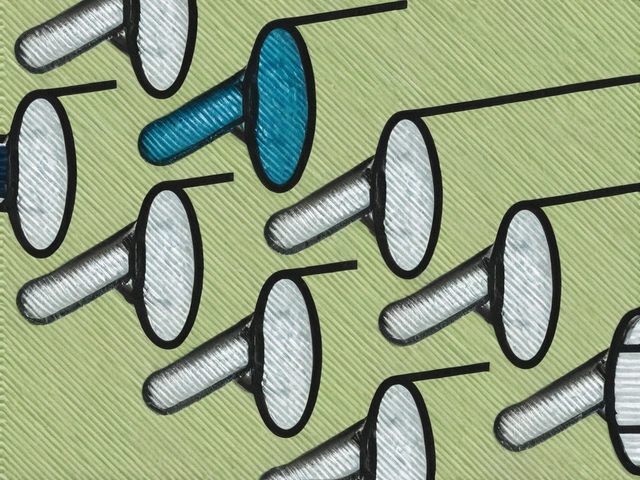Antihistamine for Motion Sickness Selector
Select Your Needs
Key Takeaways
- Meclizine works well for mild to moderate motion sickness with a low‑sedation profile.
- Scopolamine patches provide the fastest onset but can cause strong drowsiness and dry mouth.
- Dimenhydrinate and diphenhydramine are inexpensive OTC options, but their sedation is higher.
- Cyclizine and cinnarizine are popular in Europe and Australia, offering longer duration with moderate side effects.
- Choosing the right drug depends on age, activity level, and tolerance for drowsiness.
When you need relief from the queasy feeling that comes with a car ride, boat trip, or inner‑ear disorder, the first name that pops up is Meclizine. But the pharmacy aisle is crowded with other antihistamines, each promising smoother sailing. This guide breaks down how Meclizine stacks up against its most common rivals, so you can pick the one that fits your lifestyle without guessing.
Meclizine is a first‑generation antihistamine used for motion sickness and vertigo. It blocks H1 receptors in the vestibular system, dulling the signal that tells your brain you’re moving when you’re not.
Other drugs you’ll encounter include:
Dimenhydrinate (often sold as Dramamine) is an OTC antihistamine that combines diphenhydramine with 8‑chlorotheophylline to reduce drowsiness.
Cyclizine is a prescription antihistamine popular in the UK and Australia, known for a moderate sedation level.
Promethazine is a potent antihistamine that doubles as an anti‑nausea agent, usually prescribed for severe motion sickness.
Scopolamine comes as a transdermal patch that delivers the drug steadily over 72hours, making it a favorite for long trips.
Diphenhydramine (Benadryl) is an OTC sleep aid that also works against motion sickness, but its sedative effect can be a deal‑breaker.
Cinnarizine is a calcium‑channel blocker with antihistamine properties, widely used in Europe for vertigo.
How Meclizine Works
Meclizine’s core action is H1‑receptor antagonism inside the inner ear. By dampening the vestibular input, it reduces the mismatch between visual cues and balance signals that triggers nausea. The drug is absorbed quickly, reaching peak blood levels in about 2hours, and its effects can last up to 24hours.
Side‑Effect Profile
Because Meclizine is a “first‑generation” antihistamine, it can cause some drowsiness, but clinical trials report a lower sedation rating than diphenhydramine. Common complaints include dry mouth, mild constipation, and occasional blurred vision. Importantly, it does not usually cause the strong anticholinergic effects (like urinary retention) seen with some older antihistamines.
Comparing the Alternatives
Below is a quick‑look table that lines up the most relevant factors for each drug. The numbers reflect data from FDA labels, European Medicines Agency (EMA) dossiers, and large‑scale clinical studies performed between 2018 and 2024.
| Drug | Onset (hrs) | Duration (hrs) | Sedation | Prescription? | Typical Dose |
|---|---|---|---|---|---|
| Meclizine | 0.5‑2 | 8‑24 | Low‑medium | OTC (low dose) / Rx (high dose) | 25‑50mg PO |
| Dimenhydrinate | 0.5‑1 | 4‑6 | Medium‑high | OTC | 50‑100mg PO |
| Cyclizine | 1‑2 | 24‑48 | Medium | Prescription | 50mg PO |
| Promethazine | 0.5‑1 | 4‑6 | High | Prescription | 12.5‑25mg PO |
| Scopolamine (patch) | 1‑2 (via skin) | 72 (continuous) | Medium‑high | Prescription | 1.5mg/patch |
| Diphenhydramine | 0.5‑1 | 4‑6 | High | OTC | 25‑50mg PO |
| Cinnarizine | 1‑2 | 24‑48 | Medium | Prescription (some OTC in EU) | 25‑75mg PO |
When to Choose Meclizine
If you need an all‑day shield and can tolerate a mild buzz, Meclizine is a solid pick. Its low‑to‑medium sedation makes it safe for people who still need to drive or operate machinery after dosing. It’s also the only drug in this list that is available OTC in the UnitedStates at the 25mg dose, meaning you can grab a bottle without a prescription.

When an Alternative Might Be Better
- Scopolamine shines on long sea voyages or multi‑day road trips because the patch stays active for up to three days. The downside is a higher chance of dry mouth and blurry vision.
- Dimenhydrinate or Diphenhydramine are budget‑friendly for occasional trips, but the strong drowsiness can ruin a day of sightseeing.
- Promethazine is the go‑to for severe nausea, such as chemotherapy‑induced vomiting, but it’s prescription‑only and can cause significant sedation.
- Cyclizine and Cinnarizine are often favored in Europe for chronic vertigo because they last longer and have a moderate side‑effect profile.
Drug Interactions and Contra‑Indications
All these antihistamines share a common caution: combine them with alcohol, central nervous system depressants, or other anticholinergic drugs and you’ll feel the drowsiness multiply. Meclizine, like the others, should be avoided in patients with narrow‑angle glaucoma, severe urinary retention, or untreated prostatic hypertrophy.
Cost Considerations
In 2025, a 30‑day supply of OTC Meclizine averages NZ$12 in NewZealand pharmacies, while a scopolamine patch runs about NZ$45 per patch (three‑day supply). Prescription drugs such as cyclizine or promethazine are usually covered partially by NZ health insurance plans, bringing out‑of‑pocket costs down to NZ$10‑20.
Practical Tips for Using Antihistamines
- Take the medication with food or a full glass of water to reduce stomach upset.
- If you’re prone to drowsiness, schedule the dose at night and test the effect at home before a trip.
- For scopolamine patches, apply to a clean, hair‑free area behind the ear and rotate sites each new patch.
- Never exceed the recommended daily dose; higher doses do not increase efficacy but raise side‑effect risk.
- Keep a brief log of how each drug feels-onset time, sedation level, and any lingering symptoms-so you can fine‑tune your choice for future journeys.
Bottom Line
Meclizine offers a balanced mix of quick onset, all‑day coverage, and manageable sedation, making it the default for most travelers. If you need ultra‑long protection, an anti‑nausea boost, or you can’t tolerate any drowsiness, one of the alternatives will fit better. The key is matching the drug’s profile to your activity, health status, and budget.
Frequently Asked Questions
Can I take Meclizine with alcohol?
Mixing Meclizine with alcohol heightens drowsiness and impairs coordination. It’s safest to avoid alcohol for several hours after taking the dose.
How long before a flight should I take Meclizine?
Take it about 30‑60 minutes before boarding. The drug reaches peak blood levels within two hours, so a dose right before the take‑off covers most of the flight.
Is Meclizine safe for children?
In NewZealand, Meclizine is approved for children 12years and older at a reduced dose. For younger kids, doctors usually recommend dimenhydrinate or non‑pharmacologic methods.
Why does Meclizine cause dry mouth?
By blocking H1 receptors, Meclizine also reduces saliva production-a common anticholinergic effect of first‑generation antihistamines.
Can I use Meclizine for vertigo caused by Ménière’s disease?
Yes, many ENT specialists prescribe Meclizine to dampen vertigo attacks in Ménière’s patients. However, it does not treat the underlying fluid imbalance, so other therapies are usually combined.
Is it okay to switch between Meclizine and Dimenhydrinate on the same trip?
Switching is possible, but avoid overlapping doses. Allow at least 6hours between the two drugs to prevent cumulative sedation.






Jenny Spurllock
September 29, 2025 AT 14:19I appreciate the clear breakdown of each antihistamine’s onset and duration; it helps map the options to specific travel plans.
I also find the inclusion of NZ cost figures a useful geographic reference.
Bart Cheever
September 30, 2025 AT 14:46The article suffers from an excess of colloquial phrasing that undermines its credibility.
A more rigorous lexicon would elevate the discourse.
Maude Rosièere Laqueille
October 1, 2025 AT 15:13For optimal efficacy, schedule the dose about 45 minutes before departure, allowing plasma concentrations to peak during takeoff.
Additionally, patients with a history of glaucoma should consult their physician before initiating therapy, as anticholinergic effects may exacerbate intra‑ocular pressure.
Jessica Haggard
October 2, 2025 AT 15:39Great points, Maude! I’d add that travelers from diverse cultural backgrounds often prefer non‑pharmacologic methods like ginger chews, which can complement the antihistamine without adding sedation.
Alan Clark
October 3, 2025 AT 16:06Yo, the scopolamine patch is a real game‑changer for those marathon road trips-just slap it behind the ear and you’re set for three days!
Just remember to keep it dry, or the patch can lose its mojo.
Mark Anderson
October 4, 2025 AT 16:33If you’re planning a whirlwind cruise and want to dodge the seasick spiral, Meclizine is your trusty compass, steering you clear of nausea while keeping the fog of drowsiness at bay.
Its once‑daily dosing means you won’t be fiddling with pills every few hours, freeing up more time for adventure.
Shouvik Mukherjee
October 5, 2025 AT 16:59Many travelers from South Asia rely on dimenhydrinate because it’s readily available and affordable, yet they often overlook the subtle balance between effectiveness and the lingering heaviness it can cause.
Choosing the right medication is a personal journey, and I encourage sharing experiences within the community to guide newcomers.
Ben Hooper
October 6, 2025 AT 17:26The article could benefit from tighter editing.
Consistency in terminology would improve readability.
Marjory Beatriz Barbosa Honório
October 7, 2025 AT 17:53Remember to hydrate well before taking any antihistamine; dehydration can amplify dry‑mouth side effects and make the experience less pleasant.
A glass of water with your dose goes a long way.
G.Pritiranjan Das
October 8, 2025 AT 18:19Avoid mixing antihistamines with alcohol to prevent excessive sedation.
Karen Wolsey
October 9, 2025 AT 18:46Sure, because everyone loves chewing on ginger while their head is still wobbling.
But hey, if that works for you, who am I to argue.
Trinity 13
October 10, 2025 AT 19:13When you stare at the rolling horizon and feel your stomach flip like a bad stock market, it’s easy to think of nausea as just a physical nuisance, but it’s actually a subtle dialogue between the vestibular system and the brain’s expectation engine.
Pharmacologically, antihistamines become translators in that conversation, dampening the erroneous signals that the inner ear sends when your eyes see a steady scene but your balance sensors detect motion.
Meclizine, for instance, offers a moderate translation speed, enough to quiet the chatter without muting all sensory input, which is why drivers often favor it.
Scopolamine, on the other hand, delivers a heavy‑handed translation, saturating the channel for up to 72 hours; the trade‑off is a noticeable fog that can feel like trying to think through a thick fog bank.
Dimenhydrinate and diphenhydramine hand out the loudest translations, guaranteeing that the nausea signal is drowned, but they also pull the curtains on alertness, making you feel as if you’ve been hit by a tranquilizer.
One must also remember the role of anticholinergic load: these drugs reduce saliva, blur vision, and can congest the urinary tract, which are downstream effects that matter on long journeys.
From a cost perspective, Meclizine is the most accessible in the US OTC market, while scopolamine patches command a premium that not all travelers are willing to pay.
The practical tip is to align the drug’s pharmacokinetic profile with the trip length: short flights pair well with a single Meclizine tablet, whereas multi‑day cruises merit a scopolamine patch or a staggered schedule of Meclizine doses.
Don’t forget the importance of timing; taking the medication too early can lead to a “wear‑off” effect right when turbulence hits, while too late leaves you uncovered during the critical ascent phase.
Individual tolerance varies, so a log of onset, duration, and side‑effects becomes a personal travel companion.
For those with pre‑existing conditions like glaucoma or urinary retention, the choice leans away from high‑anticholinergic agents toward the milder profile of Meclizine.
In many cultures, non‑pharmacologic measures-such as ginger, acupressure bands, or controlled breathing-are used alongside antihistamines to enhance comfort without adding sedative load.
Ultimately, the best antihistamine is the one that fits your itinerary, health status, and personal tolerance, creating a seamless journey where the only thing you feel moving is the scenery, not your stomach.
Dorothy Ng
October 11, 2025 AT 19:39Your extensive rundown is thorough and well‑structured.
Minor typo: “translating” should be “translation” for consistency.
Melissa H.
October 12, 2025 AT 20:06I’ve tried the Meclizine‑dimethindrone combo on a 12‑hour bus ride and felt a pleasant balance between clarity and calm 😊.
It’s worth noting that splitting the dose-half an hour before departure and half midway-can smooth out any late‑day dip.
Edmond Abdou
October 13, 2025 AT 20:33That’s a solid tip! 😊 Sharing dosage timing tricks helps the community avoid the dreaded “mid‑trip crash.”
Benjie Gillam
October 14, 2025 AT 20:59From a pharmacodynamic standpoint, the H1‑receptor antagonism exhibited by Meclizine yields a lower Ki value relative to diphenhydramine, translating into a more favorable therapeutic index for motion‑induced nausea.
Clinically, this underpins the drug’s reputation for “light‑to‑moderate” sedation, making it compatible with post‑travel cognitive tasks.
Nevertheless, practitioners should remain vigilant about polypharmacy scenarios where additive anticholinergic burden could precipitate delirium in geriatric cohorts.
Naresh Sehgal
October 15, 2025 AT 21:26Listen up, folks-if you’re still debating between a cheap over‑the‑counter tablet and a prescribed patch, do the math on side‑effects versus trip length and make a decision now!
Don’t let indecision ruin your vacation.